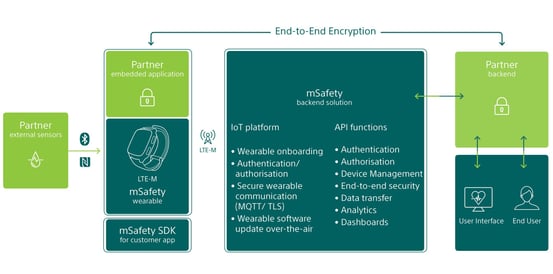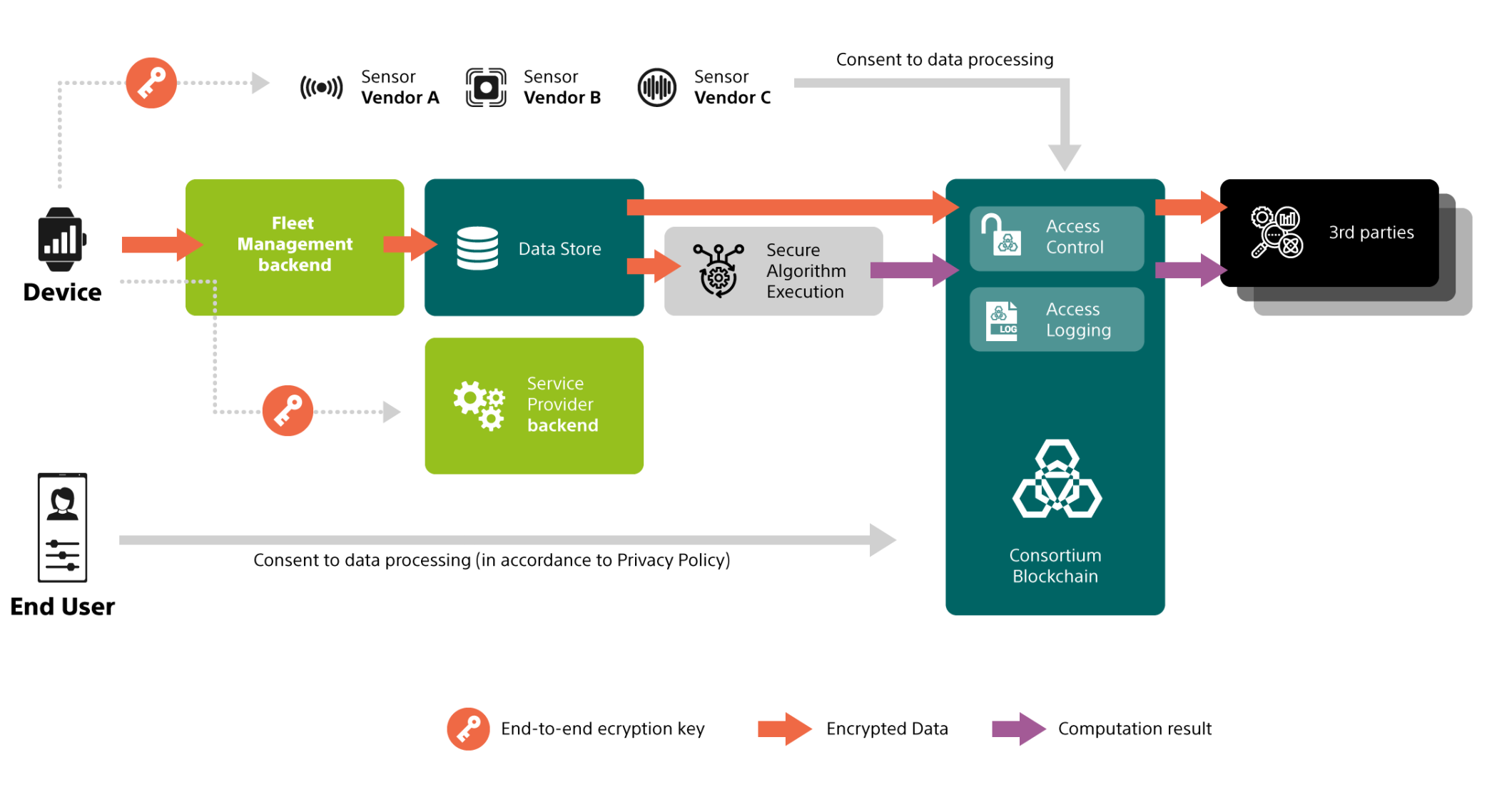The need for proactive health monitoring and Sony’s mSafety solution
Privacy, integrity and real-time insights are key
Privacy, integrity and real-time insights are key
Privacy, integrity and real-time insights are key
This article was originally published May 13, 2020, by Anders Strömberg,
Director, Head of Wearable Platform Division at Sony Network Communications Europe.
Today, we have access to a lot of user data but access to the user (or patient) is often not real-time and this makes proactive intervention difficult.
The available data is not sufficiently robust to detect negative trends and to prevent adverse outcomes.
There are trust issues from the end-users and medical care teams around the security and protection of sensitive patient data.
There has been a gap in providing a comprehensive solution that includes not only heart rate, weight, calories, temperature, or step counts but rather a combination of all to deliver the full value of remote monitoring as a proactive tool to enable improved health outcomes.
The solutions that are available today come with a high level of complexity for the end-user and the service provider that result in frustration and lack of or limited engagement.
The world has changed since the outbreak of the COVID-19 pandemic. Discussions about who is at risk, when are they at risk and how to mitigate the risk of being infected by a potentially deadly virus, are ongoing. As a result, our understanding of which groups of people should be monitored remotely is also evolving. The need for a simple method to collect data early enough to perform triage by health care providers and to continuously monitor health care provider infection status to avoid spreading the virus unintentionally is paramount and growing.
In order to obtain the right level of data and to enable interventions as early as possible, one requires a constant flow of end-use data to monitor patterns and detect changes. Some may argue that the most significant changes in health status occur over hours and not minutes, but most would agree that data points every six hours would often be too long.
If the aim is for early detection of adverse trends or events this means collecting data continuously, even during hours when one might not think to provide data points. This would apply to all populations and not just patients or health care workers. Most solutions today, still require the streaming of data to a remote server to analyse the data and detect trends. What has been lacking is a platform or product that is highly reliable, simple to use and that ensures data privacy and integrity.
Regardless of whether we are a patient, a relative, a health care worker, an employer or employee, we all require a trust-worthy end-to-end information flow and handling. If this is not the case, very few would feel comfortable in the sharing or reporting of their personal data.
Our understanding and importance of proactive insights increased dramatically due to COVID-19.
The new mindset involves not thinking only of patients but people generally. This includes the monitoring of our health care workers for symptoms and trends indicating the onset of a COVID-19 infection.
Our willingness to track our own personal data is now much higher, assuming that we trust the service provider to securely transmit our data to a remote health care team.
The remote monitoring of individuals with chronic conditions and those at high-risk has been around for many years. The remote monitoring of healthcare workers, patient’ relatives and almost healthy people is, however, a new thought. This takes the concept from something that is easily understood and accepted as mandatory to a new practice that is becoming acceptable as prudent, reasonable and the right thing to do to take care of oneself and others. More and more people, well beyond just healthcare workers that see the impact of the COVID-19 pandemic, now understand and see the value of someone keeping an eye them; the importance of monitoring changes in body temperature during working hours as part of their daily routine. The same applies to all of those employed in critical production facilities and all essential services employees that keep our economy moving forward. They also see the value of the continuous monitoring of their health status to prevent the spread the virus.
The technical capabilities for health monitoring have taken huge leap to enhance performance and reliability. Technology improvements in connectivity, battery life, sensor capacity, block chain and AI have been made more readily available for a wider set of applications.
User consent tracking, encryption and government regulations have all increased the requirements for privacy and integrity.
A seamless experience adapted on the user needs and their technology comfort level is an essential pre-requisite for providing proactive health insights. When collecting information about conditions and situations that can be viewed as sensitive, there are regulatory requirements that must be met. This means GDPR in the EU and HIPAA in the US. In addition, the service providers must explain and demonstrate to customers and users how they comply with privacy and integrity regulations. Technologies like Blockchain and AI have been demonstrated to be very useful in healthcare use cases. AI has mainly been used for post analysis and Blockchain for securing the information’s origin, quality and access rights. In the future, these technologies can be combined with encrypted search technologies and more real-time applications to enable fast, agile applications. We should not assume that ‘one size fits all’ but several key principles are common to all, such as:
Direct, frequent and bi-directional communication to collect and upload data from the end-user to the service provider. The services provider will then analyse, create and provide insights to the end-user knowing the information is reaching the end-user in real-time.
Simplicity is the key to making services accessible to users who might normally not be interested or who are not technically proficient.
The device needs a long battery life to be able to be able to collect data 24/7, and to reduce risk broken connections and consequent data loss. If the device is being managed by external care-givers, it should be quick and simple to charge during a visit.
Cybersecurity is always critical to protect the data collection, prevent entry to IT-systems and malicious use of a solution. This risk can be eliminated by using end-to-end encryption between the data creation point and the endpoint where the data is being stored and managed.
In concept, one solution could be a wearable device on a person that picks data generated by their body, near them or provided manually by the user.
The solution should not expect the user to understand and manage complex devices.
The solution should be accessible directly by the service provider.
The solution should be with the user 24/7/365.
The method or means of collecting, analysing and providing insights should be achieved using a simple device or set-up whereby a single sensor provides enough information to the end-user once the service providers have added their protocol and data analysis to that information. An example of this is a body thermometer to detect onset of fever as in the case of COVID-19 detection. However, in most cases that service could be improved by adding oxygen saturation, respiration and physical activity. Once all this information has been collected, it may be necessary for different stakeholders to share data with the consent and agreement of the user.
An open, secure and simple solution to address these challenges could be the mSafety platform, illustrated below.

Going forward, the need for data exchange between stakeholders, based on user consent and trust, will enable a better and richer service. The data and information provided through sensors, algorithms and user interaction can be made available to stakeholders for more clinically relevant AI applications and potentially enable better health outcomes for the end-user. The latest end-user consent tools and data encryption capabilities make it possible to prevent data leaks and privacy issues.

This approach can be used for drug studies or in other situations where cohort real-world data collection and analysis can identify and fine-tune pharmaceutical effectiveness among target populations, and potentially identify new or unknown drug applications.
Remote monitoring of healthcare status to improve healthcare outcomes has been a promise for many years and the availability of new technologies has increased capabilities. The improvements in outcomes, however, remain an unmet and elusive promise. One key gap has been the result of how these technologies have been deployed. The sports and fitness watches are aimed at consumers. The wearables from large technology players are aimed at consumers. The devices that include reporting to a healthcare team are cumbersome and can be difficult to use. This means only the dedicated and truly engaged users who are willing to take control of their health derive the most benefits. The missing link for many users has been the seamless and continuous connection to a healthcare team to provide the feedback and the medical advice that is required to guide patients towards improved outcomes. Beyond closing this gap, other key considerations for enabling successful applications include:
The COVID-19 pandemic, while causing distress to huge numbers of people, has made us think differently about how we approach and evaluate the need for remote monitoring. What is now quite clear is that it is not the last time we will be in a pandemic situation, and the notion that remote monitoring is only relevant for people already classified as “patients” now seems outdated.
Today, data hacking is a constant threat and the demands for data privacy and integrity are extremely high. Using the most advanced solutions and technologies can help ensure the acceptance of remote monitoring solutions even in complex deployments with multiple stakeholders.
There are many benefits with using consumer technologies for some engaged consumers, but most users do not derive significant benefits from a constant stream of data. These applications aimed at the mass market are missing the customization and “purpose-driven” aspects addressing their unique needs and the feedback and guidance necessary in order to be truly useful and impactful when it comes to improved health outcomes.
Providing a fully integrated solution that reduces the reliance on the end-user’s technical capabilities and active participation for data collection can reduce the risk of losing valuable data and enables valuable, proactive interactions with the end-user to modify behaviour.
Find out more about the mSafety service